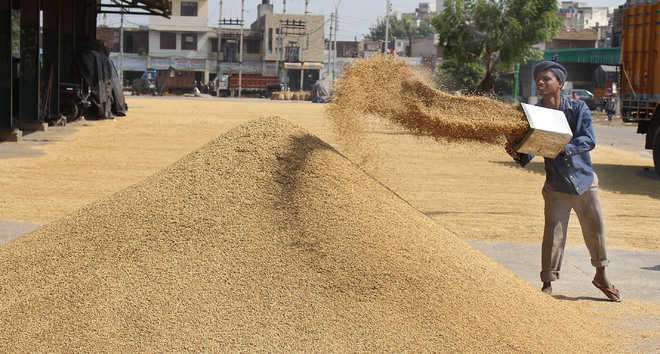In last two months protest by farmers in Delhi has brought outrages. The violent incident at Red Ford on republic day, January 26, 2021, was shameful. A life was lost due to a tractor accident during the rally by protestors and many policemen were injured. Like most of the political protests in India, this farmer protest is also divided into two groups, one supporting the protest and the other opposing it. Most of the neutral observers agree that although the protestors claim this is the protest of all the farmers across India, the fact is the protesting farmers are largely from Punjab including few groups from Haryana and Western Uttar Pradesh including their organizations. The presence of farmers from other states is almost negligible.
Politics of Party
The Communist Party of India (CPI) has strongly supported farmer protest. In the beginning flag of CPI was largely found in many such protests. Though politically communists and CPI have not succeeded much politically in Punjab, the state Punjab has a strong base of CPI in the ground for decades who have somehow link with protesting farmers. When the protesting farmers realized that it is taking political color, CPI has slowly withdrawn its flag from the protesting sites, and concentrate on gaining more support in other parts of India for the protest.
For instance, CPI flags were dominantly seen in the farmer’s protest in Mumbai, Maharastra on January 25, 2021. In few other states, opposition parties had organized farmers’ protests to gain support nationally but all of them did not meet the expectations and were of limited success or failed. The scale of farmers’ protest in other parts of the country so far has been much smaller than that was found during anti citizenship amendment act (CAA) protest a year ago.
Sikh Politics
Presently, the protest is largely concentrated around the border of Delhi and the majority of protesting farmers are from Punjab and Sikh community. There is a religious angle to this too. Bhartiya Janata Party (BJP) and its parent organization, RSS, are known to be Hindu nationalist. Both BJP and RRS politically, socially, and culturally consider the Sikh community as part of the Hindu nationalist narrative, but due to various historical reasons like the 1984 Sikh riots, Khalistan movement, etc., the majority of the Sikh community do not consider BJP as their political ideology.
This is evident from the fact that Sri Narendra Modi is one of the most popular Prime Minister among all the states in India, however, he has the lowest popularity in Punjab, because of the Sikh community. Sikh religious flags and Khalistan flags were also sighted in the protest sites. Some people think one of the reasons why Prime Minister Modi and the central Government are sympathetically considering the protesting farmers’ issue, unlike their stand during the CAA protest, and willing to take few steps back, such as postponing the implementation of farm laws 2020 for one and half years, is because BJP does not want to hurt the Sikh community besides being generally sentimental to farmers.
Paddy Production and MSP
The protesting farmers’ primary apprehension about the farm laws is Minimum Supporting Price (MSP) even though their primary demand is to repeal the farm laws. Experts claim this farm law is in the interest of farmers, then why farmers, especially in Punjab are not convinced? This is due to fact that farmers in Punjab are not worried about any other crops except paddy as it guarantees them MSP and profitability. Going back to the history of paddy procurement, there was a time India was in shortage of food and the Government of India encouraged paddy as a cash crop to meet the food demand of the country.
After the first green revolution, the Punjab region substantially contributed to the food security of India. Over the decades’ paddy remains as a cash crop in the central Government policy and through various state Governments, the central Government procures paddy which encourages many farmers in India to switch over to paddy to increase their cash income. Indeed, Punjab farmers enjoy handsomely this benefit for over a few decades. At the same time increase in irrigation facilities in other states is also substantially increasing paddy production. Today India’s paddy production is higher than its food requirement.
Paddy Price and Export
Despite India has been the biggest exporter of rice, it has not been easy to export. For instance, in 2016-17 India exported 10.3 million metric tons of rice whereas Thailand and Vietnam exported (the second and 3rd highest exporters) 10 and 5.8 million metric tons of rice respectively. This number was decreasing till 2019-20 when India exported 8.34 million tonnes. Thankfully in 2020-21 drought-like situation in some parts of Thailand and Vietnam and weakening of rupees helped the export of rice from India substantially. Indian non-Basmati rice was this year about 10 % cheaper than Thailand and Vietnam. Thus, this year 2020-21, India has already exported 11.95 million tonnes. This jump was largely in non-basmati rice, 61% after prices jumped in Thailand.
Now compare this price regionally within India. In India basmati rice production, consumption and export are by private players only. KRBL Limited who produces India Gate basmati rice is the largest rice manufacturer. The premium basmati rice is in demand in the middle east, especially Saudi Arabia, Iran, and Iraq.
Farmers who cultivate basmati in Punjab, Haryana, and Western Uttar Pradesh get a good price. Indian basmati has a price challenge from Pakistan in the export market, though India still dominates above 80 % of the basmati export market. Moreover, due to American sanctions, Iran is forced to buy basmati from India in exchange for oil, which gives some advantage. Nevertheless, the export potential is limited due to its premium price. The only way to divert India’s excess paddy production is to divert to the non-basmati export market or rot it in Food Corporation of India (FCI) godowns. Official data shows 5213.36million tons of food grains were damaged in 2018-19. It’s a huge loss of taxpayers’ money.

Procurement and Punjab
India’s price competitiveness in non-basmati rice this year is largely due to states other than Punjab and Harayana. The non-basmati price (Feb 2020) was at least 40 % higher in Punjab and Haryana compared to that in Visakhapatnam port, Mumbai port, or West Bengal. The reason for the higher price of rice in Punjab is due to MSP. Central Government procures most of the non-basmati paddy from Punjab.
For example, this 2020-21 Kharif session, out of a record procurement of 43.62 million tons from whole India, the Government of India has purchased 20.27 million tons (46.5%) from Punjab alone. If India will export at the price of Punjab, non-basmati rice will be more expensive than Thailand in the export market. So, Punjab farmers heavily depend on Government purchasing to get maximum profit. 46.5 % of purchasing from one state does not allow much Government procurement in other states. For example, in Odisha farmers are presently not able to sell their paddy, privately farmers are told particularly in Kalahandi that the target has been achieved for Government procurement, though officially it is not announced due to political sensitivity.
The good news is 90% of India’s production is for domestic consumption and the Government procures a large part of it. A small part that cannot be procured ends up with private players, mainly in states like West Bengal, Bihar, AP, MP, etc. with a lower price which finally is exported at a competitive price, mostly to Bangladesh and nearby countries. If Government fixes the MSP price for all including private players, it will kill the existing advantage for the export market and Indian non-basmati rice will be expensive for the export market. This will force Government to buy all paddy from the farmer for political reasons, which finally make more food grain rot in godowns and lose more taxpayers’ money.
In the meantime, the new farm laws, if implemented, will remove the state boundary of Mandis, making Punjab farmers vulnerable due to competition from the paddy coming from other states at a lower MSP price. Thus, the best way in the interest of Punjab farmers is to repeal the law that may not be in the interest of farmers from other states and those who are growing different crops, pulses, and vegetables.
On the other hand, the central Government is increasingly getting pressurized from other states to enhance procurement targets for each state. Unfortunately, for political reasons, the central Government is unable to reduce purchasing of paddy from Punjab and was hoping these new laws would be of help to balance it.
(The views expressed are the writer’s own)

Digambara Patra, M.Phil, PhD
Professor Department of Chemistry
American University of Beirut
Beirut, Lebanon
Web: http://myprofile.aub.edu.lb/dp03
( Images from the net )

